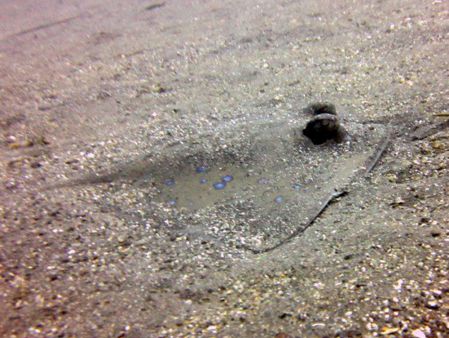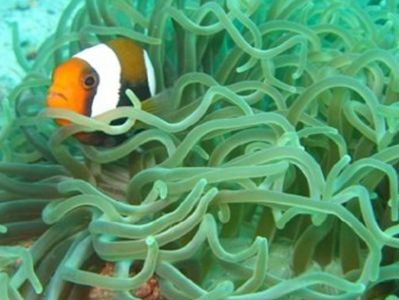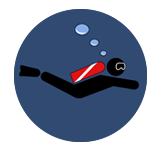This dive site gets its name for quite obvious reasons. It is covered with sea anemones over almost its entire surface, providing beautiful colours and encouraging lots of marine life to either visit or call it home. In addition, it is located right between Phuket and Koh Phi Phi, just a mile or so from Shark Point and right next to The King Cruiser Wreck. Divers from beginners to professionals are able to enjoy Anemone Reef, making it very popular, especially with boats of mixed-level diving passengers.  Blue Spotted Stingray (Neotrygon Kuhlii) Photo by Emmy AhlénThe newbies can enjoy lots of colour and life right up to within a few metres of the surface, ensuring that they can stay shallow to maximize their dive time, or if they're running low on air, can still enjoy the dive with an interesting safety stop. Professionals will usually descend right to the bottom in search of rays or sharks, then explore the nooks and crannies looking for the seahorse, porcelain crab or rare species of moray eels all reported to live here. The majority of divers visiting Anemone Reef will be certified Open Water or Advanced and can enjoy the depths, life, colour, and occasional currents. It's an easy enough dive site to navigate, as it is a limestone pinnacle which protrudes from a depth approaching thirty metres and climbs up to nearly break the surface. In fact, decades ago it could break the surface at low tides but something happened to the reef in 1997. A car ferry known as the King Cruiser crashed into the pinnacle and then sank. The top of the pinnacle was destroyed and pieces of it spread around the surrounding seabed. The coral and anemone populations recovered and now there is a wreck diving site right next door.
Blue Spotted Stingray (Neotrygon Kuhlii) Photo by Emmy AhlénThe newbies can enjoy lots of colour and life right up to within a few metres of the surface, ensuring that they can stay shallow to maximize their dive time, or if they're running low on air, can still enjoy the dive with an interesting safety stop. Professionals will usually descend right to the bottom in search of rays or sharks, then explore the nooks and crannies looking for the seahorse, porcelain crab or rare species of moray eels all reported to live here. The majority of divers visiting Anemone Reef will be certified Open Water or Advanced and can enjoy the depths, life, colour, and occasional currents. It's an easy enough dive site to navigate, as it is a limestone pinnacle which protrudes from a depth approaching thirty metres and climbs up to nearly break the surface. In fact, decades ago it could break the surface at low tides but something happened to the reef in 1997. A car ferry known as the King Cruiser crashed into the pinnacle and then sank. The top of the pinnacle was destroyed and pieces of it spread around the surrounding seabed. The coral and anemone populations recovered and now there is a wreck diving site right next door.
Being almost completely covered in anemones and soft corals means that this limestone pinnacle is a wonderful, and colourful, sight, especially on days when the visibility is good. At times when the visibility is limited, there is still plenty to see and enjoy. Obviously, among the thousands of anemones live Anemonefish (Amphiprioninae) including 'Nemo' (Ampiprion ocellaris / percula) and several other species. Invertebrates are all over the reef, but most can't be seen during the day, and reptiles including turtles and sea snakes are spotted most days. The turtles include Green (Chelonia mydas) and Hawksbill (Eretmochelys imbricata) and the highly-venomous but in reality harmless snakes are Banded Sea Kraits (Laticauda colubrina). They swim across the reef without a care in the world and are easy to spot with their black and white stripy bodies. Although there are occasional sightings of Whale Sharks (Rhincodon typus) at Anemone Reef, the chances of seeing one during the popular diving high season are quite slim. More common are Leopard/Zebra Sharks (Stegostoma fasciatum) which are ubiquitous in this part of Thailand. They are nocturnal and try to spend their days on sandy sea floors, but are nearly always disturbed by excited divers who want to get as close as possible. They will get up and swim away slowly, in search of somewhere else to find some peace and quiet. Blue-Spotted Stingrays (Neotrygon khulii) also hang around on the sandy bottom, but will dart away when approached. It should go without saying that touching any animal species while diving is a big 'no no,' both for the divers' safety and the benefit of the creatures.
 Anemonefish (Amphprioninae) Emmy AhlénMid-sized and larger schooling and reef fish at Anemone Reef include Snapper (Lutjanus), Trevally (Carangidae) and Barracuda (Sphyraena). Although most of the non-swimming life forms consist of soft corals and Gorgonian Sea fans, Parrotfish (Scarinae) will always find something harder to chomp on, and there are several species on show here at Anemone Reef. Lionfish (Pterois) glide around near to the reef without a care in the world, with their venomous spines a reminder to all that they're not to be messed with. In nooks and crannies, Moray Eels (Gymnothorax) spend their days opening and closing their tooth-filled mouths, which makes them look like they're telling divers to stay away. In truth, they are just forcing water past their gills to provide oxygen. They come out and hunt across the reef at night. There is so much at Anemone Reef that it's impossible to describe it all. It's enough to say that it's a very colourful and healthy dive site, and well worth visiting.
Anemonefish (Amphprioninae) Emmy AhlénMid-sized and larger schooling and reef fish at Anemone Reef include Snapper (Lutjanus), Trevally (Carangidae) and Barracuda (Sphyraena). Although most of the non-swimming life forms consist of soft corals and Gorgonian Sea fans, Parrotfish (Scarinae) will always find something harder to chomp on, and there are several species on show here at Anemone Reef. Lionfish (Pterois) glide around near to the reef without a care in the world, with their venomous spines a reminder to all that they're not to be messed with. In nooks and crannies, Moray Eels (Gymnothorax) spend their days opening and closing their tooth-filled mouths, which makes them look like they're telling divers to stay away. In truth, they are just forcing water past their gills to provide oxygen. They come out and hunt across the reef at night. There is so much at Anemone Reef that it's impossible to describe it all. It's enough to say that it's a very colourful and healthy dive site, and well worth visiting.
Sea conditions at Anemone Reef are generally good and suitable for all levels of diver. When visibility is low, there's still plenty to see close up. When visibility is good, it could be described as one of the best dive sites in this part of Thailand. North-south currents can be an issue at certain times of day and month, but the tour leader from Koh Lanta will have planned to dive at the best time and in the easier direction. Being out at sea and rather exposed, surface waves can sometimes affect the ease of returning to the boat after a dive, as well as make smaller boats less fun to be on. Koh Lanta dive centres generally only send larger dive boats and liveaboard diving ships here, so that is rarely a problem.

